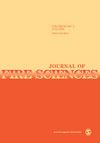Flammability and thermal stability of thermoplastic-based composites filled with natural carbon
IF 1.9
4区 工程技术
Q2 ENGINEERING, MULTIDISCIPLINARY
引用次数: 6
Abstract
This investigation characterized flammability and thermal stability for a novel sustainable composite engineered for use in building applications. Flammability and thermal stability of coal plastic composites composed of coal (40–60 wt.%) and high-density polyethylene were compared to commercial wood–plastic composites. Pyrolysis thermogravimetric analysis results indicated that coal plastic composites possessed a single-step decomposition and higher char residue, while wood–plastic composites had two-step decomposition, with the first peak occurring at much lower temperatures. Thermogravimetric analyses in air suggest coal plastic composites, compared to wood–plastic composites and neat high-density polyethylene, were more thermally stable. Flash ignition temperatures for coal plastic composites were higher than high-density polyethylene and wood–plastic composites, while self-ignition temperatures were in the same range as wood–plastic composites. Rate of burning data indicated coal plastic composites were slower burning than wood–plastic composites, with increasing coal content slowing burning rate by 19.9%–27.6%. Cone calorimeter testing showed 27% and 59% reduction in total heat release and total smoke release as coal content increased while coal plastic composite with 60 wt.% coal possessed lower overall flammability in comparison with predominant commercially available wood–plastic composite products. Coal improved composite overall thermal stability and flammability by acting as char former and foaming agent.天然碳填充的热塑性基复合材料的可燃性和热稳定性
这项研究的特点是可燃性和热稳定性的新型可持续复合材料工程用于建筑应用。对煤(40 - 60% wt.%)和高密度聚乙烯组成的煤塑复合材料的可燃性和热稳定性与市售木塑复合材料进行了比较。热解热重分析结果表明,煤塑复合材料具有单步分解和较高的焦渣,而木塑复合材料具有两步分解,且第一峰发生在较低的温度下。空气中的热重分析表明,与木塑复合材料和整齐的高密度聚乙烯相比,煤塑复合材料的热稳定性更高。煤塑复合材料的闪燃温度高于高密度聚乙烯和木塑复合材料,自燃温度与木塑复合材料相同。燃烧速率数据表明,煤塑复合材料的燃烧速度比木塑复合材料慢,煤含量的增加使燃烧速率降低了19.9%-27.6%。锥形量热计测试表明,随着煤含量的增加,总放热量和总放烟量分别减少27%和59%。与主要的市售木塑复合产品相比,煤具有较低的总体可燃性。煤作为成焦剂和发泡剂,提高了复合材料的整体热稳定性和可燃性。
本文章由计算机程序翻译,如有差异,请以英文原文为准。
求助全文
约1分钟内获得全文
求助全文
来源期刊

Journal of Fire Sciences
工程技术-材料科学:综合
CiteScore
4.00
自引率
0.00%
发文量
14
审稿时长
2.5 months
期刊介绍:
The Journal of Fire Sciences is a leading journal for the reporting of significant fundamental and applied research that brings understanding of fire chemistry and fire physics to fire safety. Its content is aimed toward the prevention and mitigation of the adverse effects of fires involving combustible materials, as well as development of new tools to better address fire safety needs. The Journal of Fire Sciences covers experimental or theoretical studies of fire initiation and growth, flame retardant chemistry, fire physics relative to material behavior, fire containment, fire threat to people and the environment and fire safety engineering. This journal is a member of the Committee on Publication Ethics (COPE).
 求助内容:
求助内容: 应助结果提醒方式:
应助结果提醒方式:


